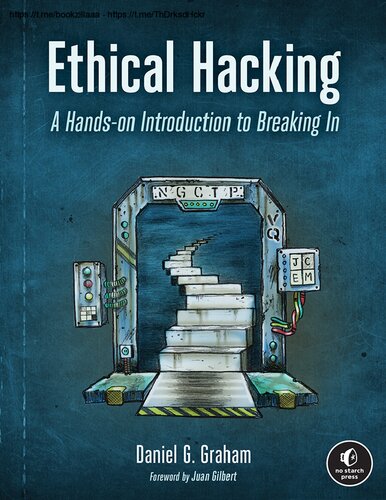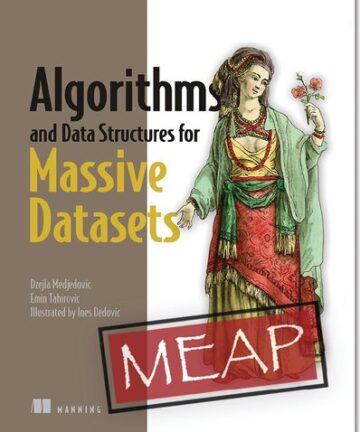Description
Ethical Hacking: A Hands-on Introduction to Breaking In BOOK
Ethical Hacking: A Hands-on Introduction to Breaking In is a book that focuses on the field of ethical hacking, also known as penetration testing or white hat hacking. It introduces the concepts, tools, and techniques used in ethical hacking for assessing the security of computer systems and networks.
Ethical Hacking by Danial.G.Graham pdf chapters:
The book covers a variety of topics related to ethical hacking, including:
Introduction to Ethical Hacking: It provides an overview of ethical hacking, its purpose, and the difference between ethical and malicious hacking.
Footprinting and Reconnaissance: This section examines the initial stages of gathering information about a target system or network, including footprinting, scanning, and enumeration techniques.
Network and System Penetration: Examines various methods of exploiting network infrastructure and operating system vulnerabilities. It covers topics such as password cracking, privilege escalation, and remote access.
Web Application Hacking: This section focuses on common vulnerabilities in web applications, such as injection attacks, cross-site scripting (XSS), and session hijacking.
Wireless Network Hacking discusses security issues associated with wireless networks and techniques for exploiting them, including sniffing, rogue access points, and cracking wireless encryption.
Social Engineering: This chapter explores the art of manipulating people to gain unauthorized access or reveal confidential information. Covers techniques such as phishing, spoofing, and hate speech.
Maintaining Access and Covering Tracks: Covers methods of maintaining access and coverage tracks to infected systems to avoid detection.
Throughout the book, readers are provided with practical exercises and real-world examples to reinforce concepts and develop the practical skills of ethical hacking. The book emphasizes the importance of ethical and legal conduct,
legal considerations, and responsible use of hacking techniques for security purposes.
It is worth noting that as an AI language model, I don’t have access to specific book contents unless they are publicly available. The provided information is a general overview of what one might expect to find in a book on ethical hacking.
Ethical hacking and related skills
Abstract
This article is about hacking and ethical hacking knowledge. Ethical hacking has been one of the most essential needs for business owners and common people. It is an activity that protects against cyberattacks and crimes and secures the systems from stealing information and assets. An ethical hacker is a computer and network specialist who is skilled in programming tools.
overview
Hacking is one of the biggest cybercrimes in the world. The hackers steal private data, money, and other information from big companies and the public. Business owners need to secure their data in their systems, and ethical hackers provide this protection against cybercrimes.
What is hacking?
Hacking is a way of accessing a computer or network and extracting all the data and information from it. We live in the age of artificial intelligence, and using a computer or network is inevitable. The system that we use needs to be secured in order to avoid hacking and gaining access.
What are the required skills to be a hacker?
Hackers are specialists in data and information extraction who are skilled in building special programming tools. They must comprehend the system of computers and networks. Professional hackers know the internet and search engines.
What are the types of hacking tools?
There are 10 popular tools in hacking, which are: Netsparker, Akunetix, Burp Suite, Luminati,Ettercap, Aircrack, Angry IP Scanner, GFI Landguard, Hashcat, and Rainbowcrack. Hackers must be skilled in networks and SQL, too. Job vacancies for this profession are very great, and hackers can find jobs easily.
Discussion
Why is ethical hacking necessary?
Data and private information are all business assets, and they must be protected from all cyberattacks. Ethical hacking secures the system through special rules such as protection of privacy and data and reporting all of the organization’s weaknesses. Ethical hacking is a legal activity because it helps protect against hacking attacks and crimes. Ethical hacking increases the security of a system or network in companies, and they will be safe against data hacking or stealing assets. Ethical hacking is a subset of cybersecurity that focuses on identifying and solving vulnerabilities in a system.
Several types of ethical hacking
Password security, wireless network security, web application security, and network security
This section focuses on securing computer networks from potential threats. Topics may include network scanning, firewall configuration, intrusion detection systems (IDS), virtual private networks (VPNs), and secure network architecture. Practices of network security best practices and effective countermeasures against common attacks.
Web Application Security: You will learn the security techniques of web applications and the basics of web application vulnerabilities like SQL injection, cross-site scripting (XSS), and cross-site request forgery (CSRF). Techniques for testing web applications, securing web servers, and implementing secure coding techniques will be explained in this section.
Wireless Network Security: Special challenges and vulnerabilities associated with wireless networks, securing Wi-Fi networks, encryption protocols, rogue access point detection, and wireless access testing are covered in this section. You will gain knowledge of best practices to protect wireless networks from unauthorized access.
Password Security: The focus of this section is on the consideration of strong passwords and the vulnerabilities related to weak or unsuitable passwords. You will learn how to choose a password and its cracking techniques, password policy enforcement, and password storage.
wireless network description and its connection
A wireless network is a system for linking computers that uses radio waves. In order to use this network, you need a device such as a computer, laptop, tablet, or smartphone. All network connections are accessed by radius linking, and your system must be equipped with this option. When you turn on network, all internet networks will appear, and if one network doesn’t need a password to be connected, you just need to click on connect.” If it is password-secured, you have to enter the correct password to be connected.
How do systems get threatened?
Systems of computers and networks get threatened by non-physical cases that stop computers from working. There are several types of these non-physical attacks, such as viruses, worms, adware, and so on. When a system is threatened by a virus or worm, it might face several threats, such as losing data information and cyber security damages.
How do you protect a system against non-physical threats?
All systems of organizations must secure their information and data in a special place on the computer, for example, drivers D or E. The next step is to install a strong anti-virus on it. The next step is caring about the website entrance authority; it is very important not to enter or do activities such as downloading from unauthorized websites.
What is cybercrime?
Cybercrime is an illegal activity that includes stealing information or private data, doing illegal bank transfers, spreading viruses or worms on computers, and other harmful activities that threaten business owners or the public.
Sometimes cybercriminals do their illegal activities by phone or by sending SMS.
What is cryptography, and how can you protect a business with this knowledge?
When you have a house, it needs to have doors and locks. Your house is all you have, and you have to secure it. Your information and data have the same conditions, and they need to be protected against thieves. Cryptography is a new cyber-knowledge that helps you convert all of your information and private data into nonhuman-readable concepts and formats and hide the real meaning of special secretive words. For example, a real sentence like I love apples will be encrypted to KNQXG CRRNGV.
• Deploying the Metasploit framework’s reverse shells and embedding them in innocent-seeming files
• Capturing passwords in a corporate Windows network using Mimikatz
• Scanning (almost) every device on the internet to find potential victims
• Installing Linux rootkits that modify a victim’s operating system
• Performing advanced Cross-Site Scripting (XSS) attacks that execute sophisticated JavaScript payloads
ethical hacking: a hands-on introduction to breaking in
Results
Ethical hacking is a must for everyone who cares about his or her data and information, especially If you are one of the people who needs to protect private information, such as a bank account, ethical hacking will empower your data security and secure your system and data. Using an antivirus is one of the most popular ways for common people to secure their systems, so if you visit many websites, you need to install an antivirus on your computer because all websites aren’t secure and they might have worms or viruses.






Reviews
There are no reviews yet.